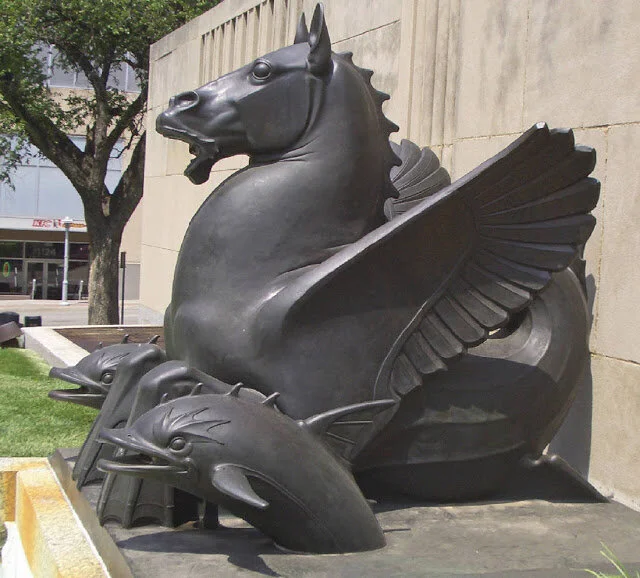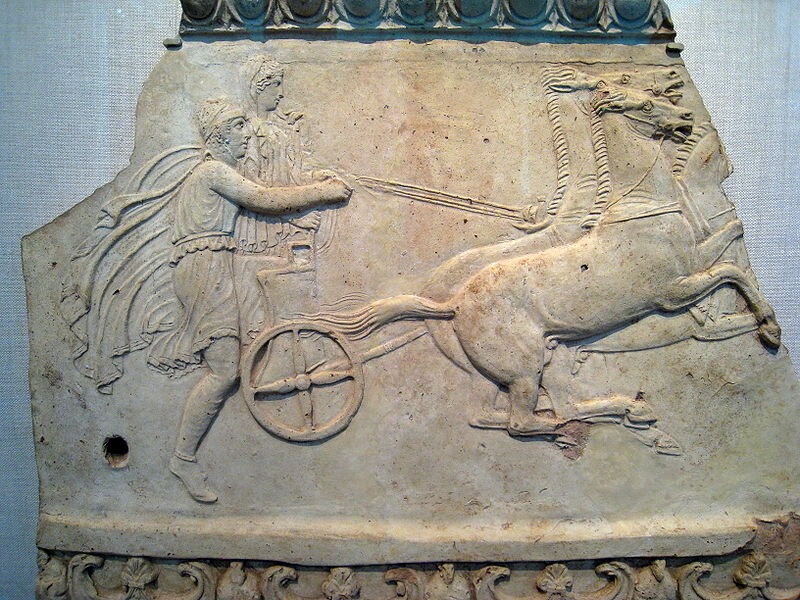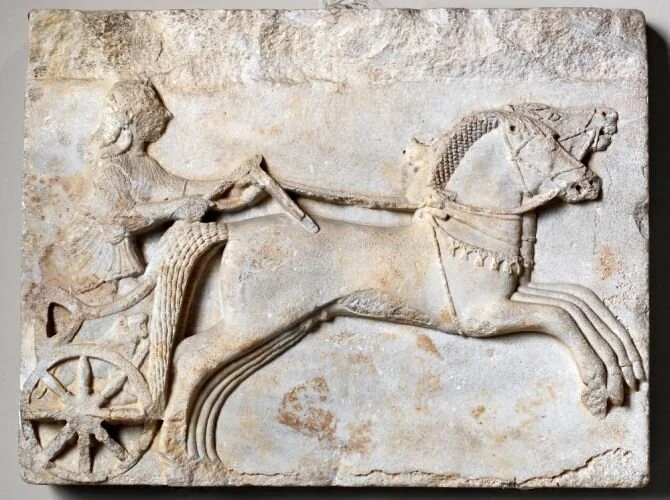Our ancestors had a word specifically dedicated to one of their worst nightmares.
Taraxippus was the name of the demon that terrified the horses at the horse races, a tormented soul that haunted the horse races of Greece and could only be calmed with sacrifice.
Taraxippus was basically a multitude of demons that lurked the racetracks and caused horses to faint, resulting in chariot crashes and injuries or the death of chariots.
Taraxippus was no small thing, which, as Pausanias tells us, was more of an adjective attributed to the demons of the Hippodrome than a self-existent being. The demon wreaked havoc and destruction at the horse races and had to be made to leave the horses and their riders alone.
Each city-state had its own Taraxippus, but the most famous was in Olympia. He would set them up in the curves of the racecourse and when the horses passed he would come out and frighten them. Invisible of course on the chariots, all you could see of him were the terrible consequences of his actions.
This is why the ancient Greeks made sure to erect altars in the curves of the horse races and the riders would offer propitiatory sacrifices in his name before the races, as Pausanias writes.
The Taraxippus of Olympia
Greek mythology mentions several famous Taraxippus, but none of them is more famous and fearsome than the Taraxippus of Olympia. The great poet of the Hellenistic years Lycophron Chalcideus tells us that he was a giant who was buried in the Hippodrome and chased the horses.
Alternatively, he was the son of a giant, a local noble who had sacrificed himself to appease the gods and end a prolonged drought. Others attribute Taraxippus of Olympia to the mighty charioteer Olenios of Olympia, who was killed in a battle, or even to Dameon, the companion of Hercules in war.
As we know from Greek mythology, Dameon followed Hercules on his odyssey against Augeas and his subsequent show of strength but was killed by Kteatis. According to tradition, his faithful horse was buried beside him and haunted the area, which later became Olympia Hippodrome.
Pausanias, however, tells us that all this is a legend and that Taraxippus was associated exclusively with Poseidon, the god of the sea and horses. Poseidon killed Hippolytus, the son of Theseus, by sending a raging bull to frighten the horses of his chariot. The chariot eventually overturned and Hippolytus was killed by the real Taraxippus.
Greek mythology lists several more names as possible protagonists of the racehorse demon, and they all have to do with local heroes who were killed in equestrian competitions. In other words, it could well have been the spirit of someone who had laid down their life on the carousel.
However, there is a tantalizing tale that comes to us from the House of Atreides that is worth mentioning.
The cunning king Oinomaos and his legendary chariot race with Pelops
The father of the accursed king of Mycenae, Atreas, and grandfather of Menelaus and Agamemnon, was Pelops, son of Tantalus, whose crime spread like a scourge over the whole genus of the Tantalids. So after Pelopas survived the adventure with his father, who cut him to pieces and fed him to the gods (!), he wanted to marry not just a woman, but the beautiful Hippodameia, daughter of King Oenomaus of Pisa (a city-state in ancient Ilia).
Pelops loved to get himself into trouble, since Oenomaus had killed so many dozens of would-be bridegrooms, having received an oracle that his groom would eventually kill him (according to another version, he had Hippodameia as a mistress and would not share her). And so he challenged the suitors to an endurance chariot race from the temple of Zeus in Olympia to the temple of Poseidon in the Isthmus of Corinth.
A chariot race he knew he would win, of course, since the son of Ares as he was, had divine horses in his chariot. In fact, Oenomaus ended up taking the fight and his opponent's head each time, according to the original agreement, which he posted on poles around his palace. According to local legends, some of the suitors became Taraxippus, such as Alcathos, the king of Megara. Thus Pausanias mentions that because they lost in the chariot race, they became hostile elements to any horseman.
Undaunted by all this, Pelopas, though he knew the setup of the matter, said that he should try his luck. And he said he should try because of course, he would not leave it to chance. He had also the favor of the gods, because not only were they not devour him when his father cut him up and served him to them, but at the command of Zeus Clotho matched all his pieces together by bringing him to life again.
Pseudo-Apollodorus tells us in the "Library of Apollodorus" that Poseidon gave him a winged chariot with such powers that he could even walk in the sea without getting wet. Nevertheless, the battle was ambiguous, so he took another step: he bribed the famous driver of Oenomaus, Myrtilos, son of Hermes, to sabotage the royal chariot.
Pelops promised him that he would give him half the kingdom or Hippodameia for one night, whatever Myrtilos decided if he would help him win Oenomaus. And so it was, the trusted driver replaced the brass nails on the axles of the royal chariot with wax and the rest was to be history.
As soon as the chariot race of Pisa began, Oinomaeus' chariot overturned and the king was killed. Or, according to the other version, Pelopas defeated him outright with the winged chariot of Poseidon and then killed him himself, escaping with Hippodameia and Myrtilos. However, when the latter challenged him to claim his reward by choosing the night with Hippodameia, Pelopas killed him too. He even tried to rape her, incurring the wrath of her now-legitimate husband.
So the Taraxippus of Olympia in this version was either King Oinomaos or the impostor Myrtilos. The latter cursed Pelops and his curse spread over the House of Atreides, with the well-known consequences. Pelops, on the other hand, to appease the dead Myrtilos, consecrated a dam to him, and sacrificed in his honor to appease his wrath, as Pausanias testifies.
There is another myth associated with the Taraxippus of Olympia, which is even more bizarre than the others. According to him, Pelops buried near the Hippodrome a mysterious object given to him by the Theban hero Amphion of Antiope, and according to Pausanias, it was this that frightened the horses of Oenomaeus, as well as every other horse since.
Pausanias reveals that this story was told by an Egyptian, and tells us that it may be true since Amphion had magical powers. After all, didn't the divine melodies of his lyre lift the stones that formed the first walls of seven-gated Thebes by themselves?
Another notorious Taraxippus was the one who panicked the horses at Corinth. This was probably Glafkos, the son of Sisyphus, who haunted the Isthmus racecourse because he had died tragically. He had been taking part in the athletic contests organized by Akastos for the dead father of Pelias when, according to the most famous version quoted by the Latin scholar Gaius Julius Hyginus, he was devoured by his horses, who went mad drinking water from an enchanted cistern.














